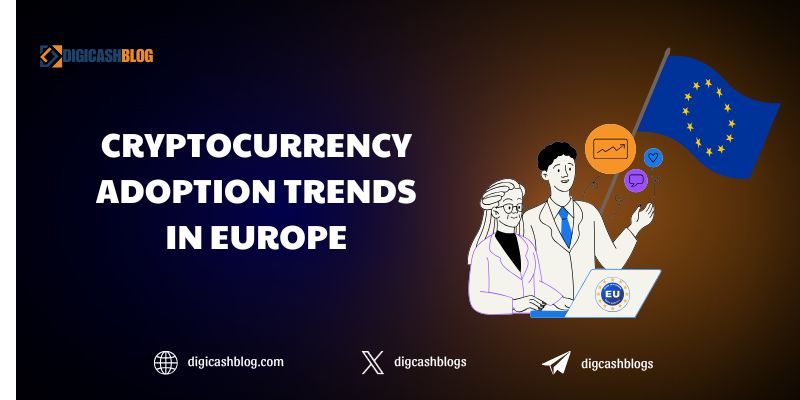Introduction to Cryptocurrency Adoption in Europe
The cryptocurrency landscape in Europe has undergone significant transformation, positioning the region as a key player in global blockchain innovation. Cryptocurrency adoption trends in Europe reflect a blend of regulatory advancements, institutional interest, and retail enthusiasm. As of 2025, Europe hosts approximately 31 million crypto users, trailing Asia and North America but showing robust growth, particularly in Eastern Europe. This article explores the drivers, challenges, and emerging patterns shaping crypto adoption across the continent.
Key Drivers of Crypto Adoption
Regulatory Clarity with MiCA
The European Union’s Markets in Crypto-Assets (MiCA) regulation, fully implemented by December 2024, has been a game-changer. MiCA provides a unified legal framework for crypto-assets, fostering trust among investors and businesses. Stablecoin regulations, effective since mid-2024, have boosted their adoption for payments and DeFi applications. Experts note that MiCA’s clarity encourages institutional participation, with firms like Société Générale securing crypto licenses to offer custody and trading services.
Institutional Investment Surge
Institutional adoption is a major driver, with European banks and fintechs expanding into crypto-assets. A 2025 report by Gemini highlights record-breaking adoption levels, with 58% of institutional investors globally holding digital assets in 2024, a trend mirrored in Europe. Countries like Germany and Switzerland lead, with over 5 million users in Germany alone, driven by banks offering crypto-related services. The approval of Bitcoin and Ethereum ETFs has further legitimized crypto as an asset class, attracting traditional investors.
DeFi and Stablecoin Growth
Decentralized Finance (DeFi) dominates Europe’s crypto economy, accounting for 54.8% of on-chain value received in Central, Northern, and Western Europe (CNWE) from July 2022 to June 2023. Stablecoins like USDT and USDC are increasingly used for remittances and payments, particularly in countries with high inflation or banking challenges. The launch of MiCA-compliant euro stablecoins, such as EURØP on the XRP Ledger, enhances regulated DeFi and tokenized asset ecosystems.
Eastern Europe’s Grassroots Momentum
Eastern Europe leads in grassroots adoption, with Ukraine, Turkey, and Russia ranking high on the 2023 Chainalysis Global Crypto Adoption Index. Ukraine, with over 6 million crypto users, leverages cryptocurrencies for humanitarian aid and transactions amid conflict. This region’s adoption is driven by retail users seeking financial inclusion and alternatives to traditional banking.

Regional Variations in Adoption
Central, Northern, and Western Europe (CNWE)
CNWE is the world’s second-largest crypto economy, receiving $987.25 billion in on-chain value from July 2023 to June 2024, a 44% year-over-year growth. The UK leads with $217 billion in crypto activity, followed by Germany and France. Bitcoin transactions below $1 million grew by 75%, while stablecoins gained significant market share. Tokenization of real-world assets (RWAs), such as real estate and art, is also gaining traction, particularly in Austria and France.
Eastern Europe’s Unique Dynamics
Eastern Europe’s crypto usage dipped by 22% in transaction volume due to economic impacts from the Russia-Ukraine war, but retail activity remains strong. Ukraine’s integration with the EU and MiCA-compliant regulations are expected to drive further growth. Russia, despite restricted access to international platforms, maintains significant institutional activity.
Challenges to Widespread Adoption
Regulatory Complexity
While MiCA provides clarity, cross-border compliance remains complex. Varying tax regulations across EU nations create challenges for users and businesses, potentially leading to noncompliance. Harmonizing regulations across all member states is a work in progress, which may slow adoption in some regions.
Education and Awareness Gaps
Despite growing interest, a knowledge gap persists. Many Europeans remain unaware of crypto’s benefits and risks, leading to mistrust. Comprehensive education programs, as suggested by industry stakeholders, are needed to demystify cryptocurrencies and boost retail participation.
Illicit Activity Concerns
High rates of illicit crypto exposure in some countries, such as Russia, pose challenges. Fraud, scams, and sanctions-related activities require robust regulatory oversight and advanced blockchain analytics to maintain trust.

Strategies to Enhance Adoption
Leveraging Blockchain Innovation
European startups are innovating in DeFi and blockchain development, particularly in hubs like Paris and Switzerland’s Crypto Valley. Platforms like Millionero simplify trading for beginners, while copy trading and referral programs encourage participation.
Promoting Financial Inclusion
Cryptocurrencies offer solutions for unbanked populations, especially in Eastern Europe. Platforms supporting offline functionality and multi-currency wallets can drive adoption in regions with unstable banking systems.
Collaboration with Traditional Finance
Partnerships with payment giants like Mastercard and banks like HSBC are integrating crypto into mainstream finance. These collaborations enhance user-friendliness and trust, accelerating adoption.
Future Outlook
The future of cryptocurrency adoption trends in Europe is promising, driven by regulatory advancements, institutional investment, and DeFi growth. The European Central Bank’s exploration of a digital euro could further legitimize digital assets. As Europe balances innovation with regulation, it is poised to become a global hub for blockchain technology, with countries like Slovenia and Ukraine leading the charge.
Europe’s cryptocurrency adoption is accelerating, fueled by MiCA, institutional interest, and grassroots enthusiasm. While challenges like regulatory complexity and education gaps persist, strategic initiatives and innovation are paving the way for broader acceptance. Staying informed about cryptocurrency adoption trends in Europe will empower investors and businesses to capitalize on this dynamic market.
